Все способы:
- «Журнал ошибок» в Виндовс 10
- Включение логирования
- Запуск «Просмотра событий»
- Анализ журнала ошибок
- Вопросы и ответы: 5
Во время работы операционной системы, как и любого другого программного обеспечения, периодически возникают ошибки. Очень важно уметь анализировать и исправлять подобные проблемы, дабы в будущем они не появлялись снова. В ОС Windows 10 для этого был внедрен специальный «Журнал ошибок». Именно о нем мы и поговорим в рамках данной статьи.
«Журнал ошибок» в Виндовс 10
Упомянутый ранее журнал является лишь небольшой частью системной утилиты «Просмотр событий», которая по умолчанию присутствует в каждой версии Windows 10. Далее мы разберем три важных аспекта, которые касаются «Журнала ошибок» — включение логирования, запуск средства «Просмотр событий» и анализ системных сообщений.
Включение логирования
Для того чтобы система могла записывать все события в журнал, необходимо включить его. Для этого выполните следующие действия:
- Нажмите в любом пустом месте «Панели задач» правой кнопкой мышки. Из контекстного меню выберите пункт «Диспетчер задач».
- В открывшемся окне перейдите во вкладку «Службы», а затем на самой странице в самом низу нажмите кнопку «Открыть службы».
- Далее в перечне служб нужно найти «Журнал событий Windows». Убедитесь, что она запущена и работает в автоматическом режиме. Об этом должны свидетельствовать надписи в графах «Состояние» и «Тип запуска».
- Если значение указанных строк отличается от тех, что вы видите на скриншоте выше, откройте окно редактора службы. Для этого кликните два раза левой кнопкой мыши на ее названии. Затем переключите «Тип запуска» в режим «Автоматически», и активируйте саму службу путем нажатия кнопки «Запустить». Для подтверждения нажмите «OK».


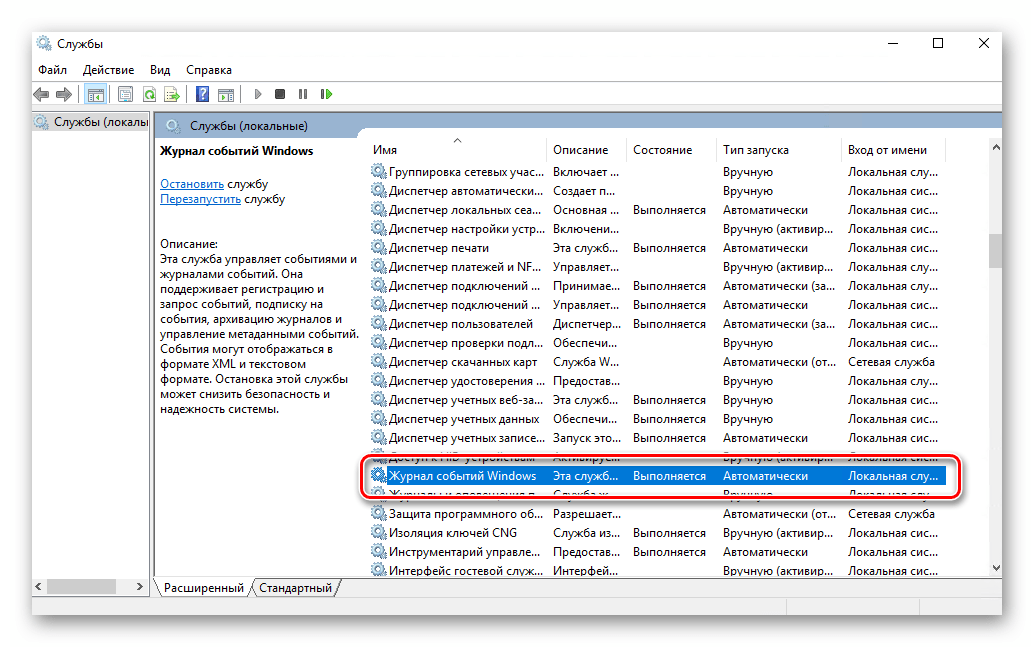
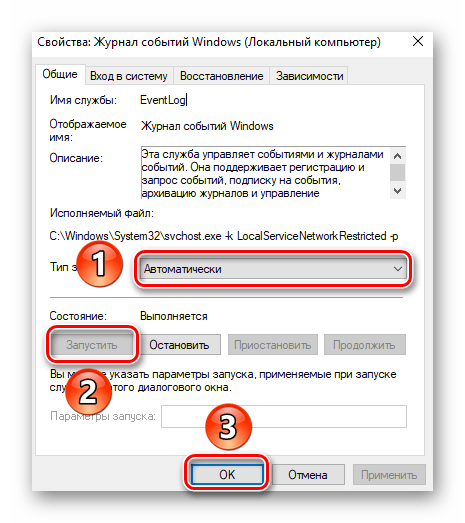
После этого остается проверить, активирован ли на компьютере файл подкачки. Дело в том, что при его выключении система попросту не сможет вести учет всех событий. Поэтому очень важно установить значение виртуальной памяти хотя бы 200 Мб. Об этом напоминает сама Windows 10 в сообщении, которое возникает при полной деактивации файла подкачки.
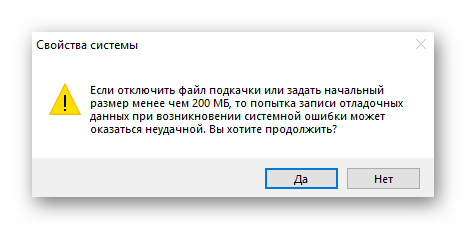
О том, как задействовать виртуальную память и изменить ее размер, мы уже писали ранее в отдельной статье. Ознакомьтесь с ней при необходимости.
Подробнее: Включение файла подкачки на компьютере с Windows 10
С включением логирования разобрались. Теперь двигаемся дальше.
Запуск «Просмотра событий»
Как мы уже упоминали ранее, «Журнал ошибок» входит в состав стандартной оснастки «Просмотр событий». Запустить ее очень просто. Делается это следующим образом:
- Нажмите на клавиатуре одновременно клавишу «Windows» и «R».
- В строку открывшегося окна введите
eventvwr.mscи нажмите «Enter» либо же кнопку «OK» ниже.
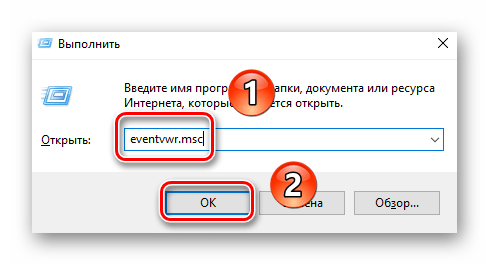
В результате на экране появится главное окно упомянутой утилиты. Обратите внимание, что существуют и другие методы, которые позволяют запустить «Просмотр событий». О них мы в деталях рассказывали ранее в отдельной статье.
Подробнее: Просмотр журнала событий в ОС Windows 10
Анализ журнала ошибок
После того как «Просмотр событий» будет запущен, вы увидите на экране следующее окно.
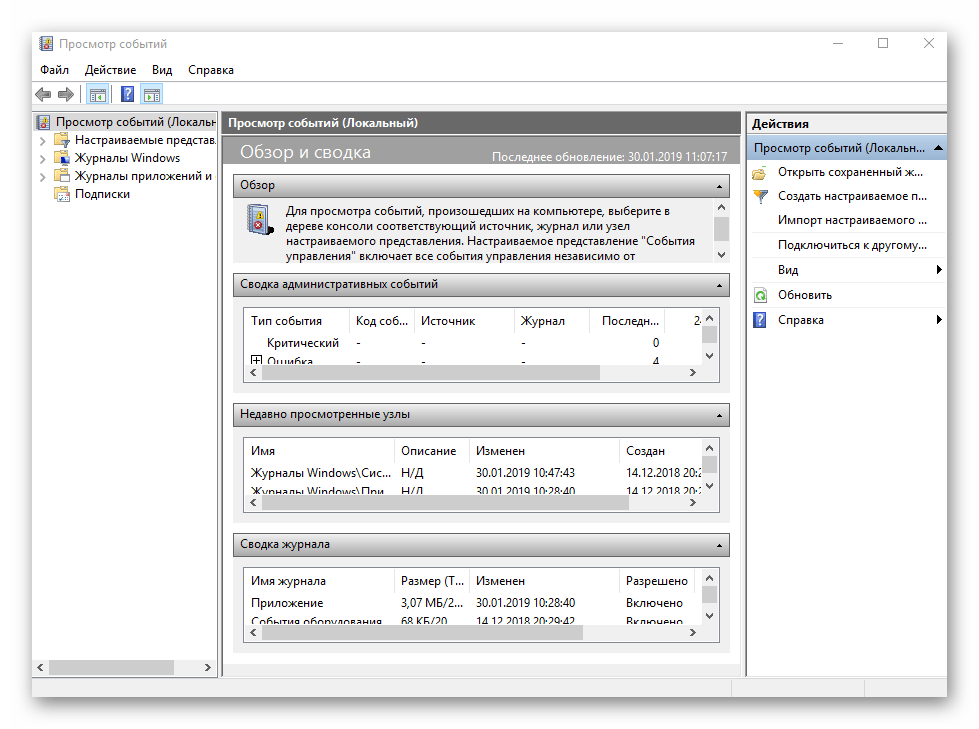
В левой его части находится древовидная система с разделами. Нас интересует вкладка «Журналы Windows». Нажмите на ее названии один раз ЛКМ. В результате вы увидите список вложенных подразделов и общую статистику в центральной части окна.
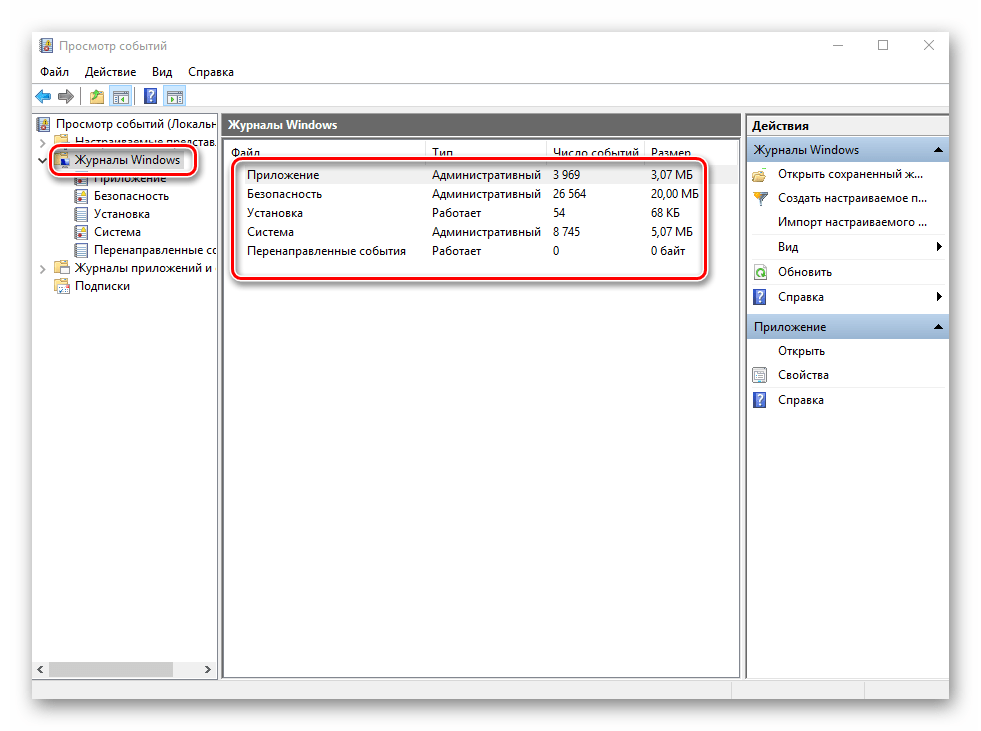
Для дальнейшего анализа необходимо зайти в подраздел «Система». В нем находится большой список событий, которые ранее происходили на компьютере. Всего можно выделить четыре типа событий: критическое, ошибка, предупреждение и сведения. Мы вкратце расскажем вам о каждом из них. Обратите внимание, что описать все возможные ошибки мы не можем просто физически. Их много и все они зависят от различных факторов. Поэтому если у вас не получится что-то решить самостоятельно, можете описать проблему в комментариях.
Критическое событие
Данное событие помечено в журнале красным кругом с крестиком внутри и соответствующей припиской. Кликнув по названию такой ошибки из списка, немного ниже вы сможете увидеть общие сведения происшествия.
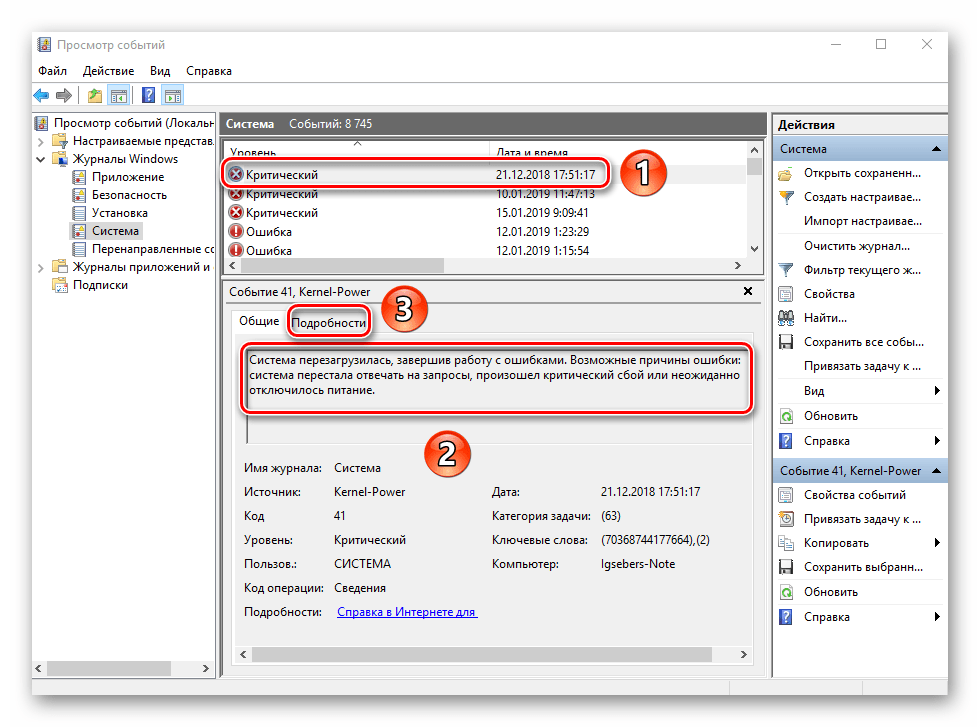
Зачастую представленной информации достаточно для того, чтобы найти решение проблемы. В данном примере система сообщает о том, что компьютер был резко выключен. Для того чтобы ошибка не появлялась вновь, достаточно просто корректно выключать ПК.
Подробнее: Выключение системы Windows 10
Для более продвинутого пользователя есть специальная вкладка «Подробности», где все событие представлены с кодами ошибок и последовательно расписаны.
Ошибка
Этот тип событий второй по важности. Каждая ошибка помечена в журнале красным кругом с восклицательным знаком. Как и в случае с критическим событием, достаточно нажать ЛКМ по названию ошибки для просмотра подробностей.
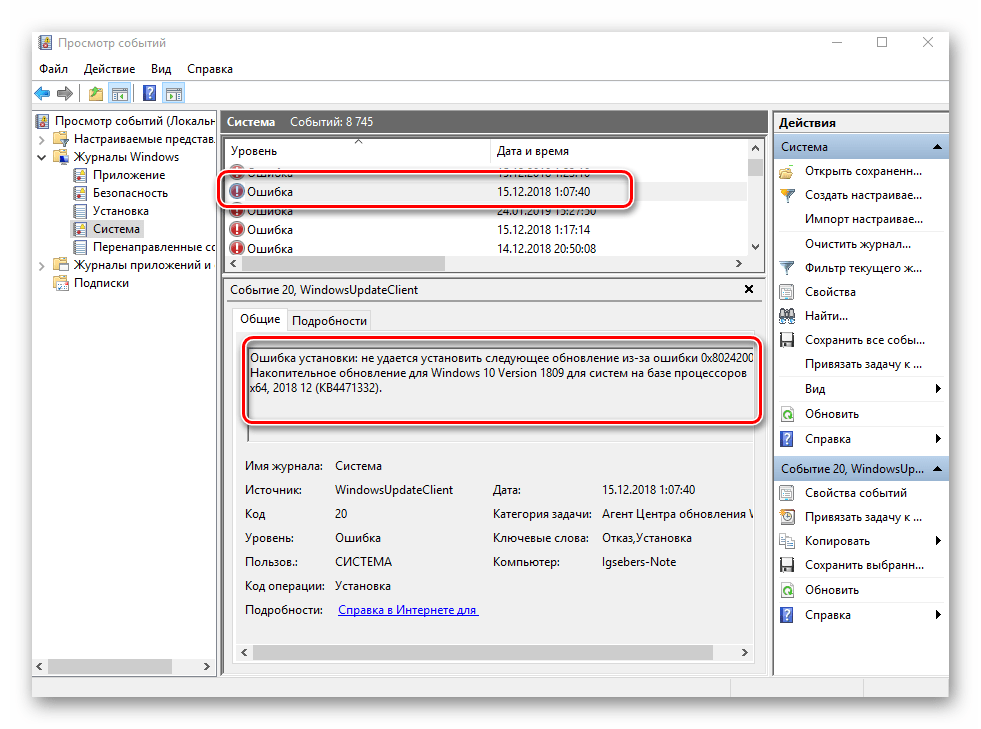
Если из сообщения в поле «Общие» вы ничего не поняли, можно попробовать найти информацию об ошибке в сети. Для этого используйте название источника и код события. Они указаны в соответствующих графах напротив названия самой ошибки. Для решения проблемы в нашем случае необходимо попросту повторно инсталлировать обновление с нужным номером.
Подробнее: Устанавливаем обновления для Windows 10 вручную
Предупреждение
Сообщения данного типа возникают в тех ситуациях, когда проблема не носит серьезный характер. В большинстве случаев их можно игнорировать, но если событие повторяется раз за разом, стоит уделить ему внимание.
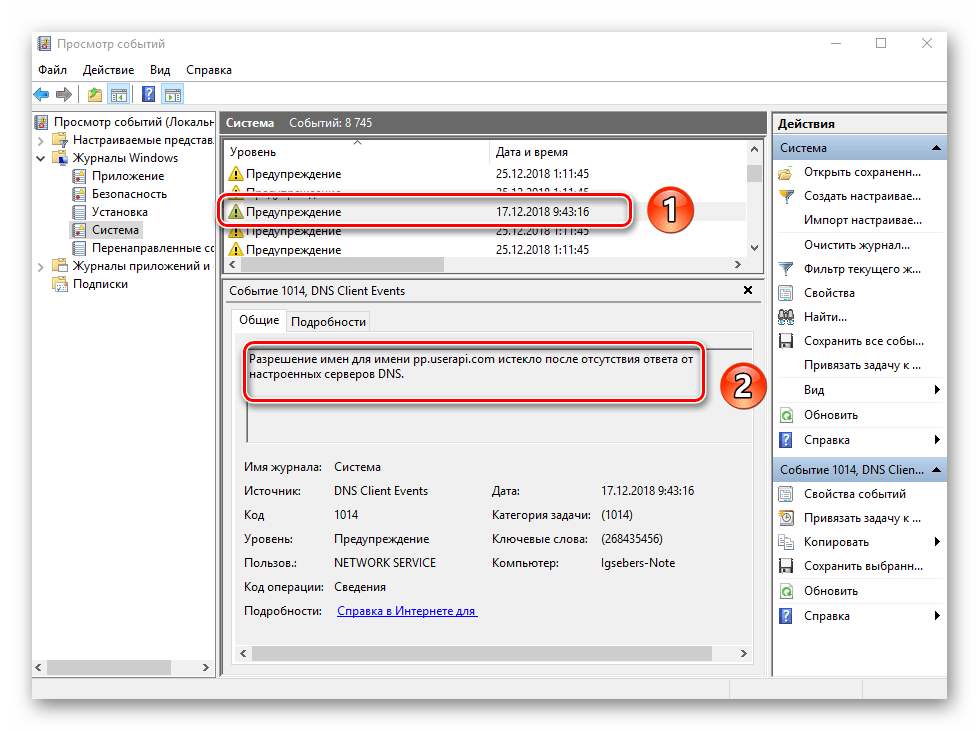
Чаще всего причиной появления предупреждения служит DNS-сервер, вернее, неудачная попытка какой-либо программы подключиться к нему. В таких ситуациях софт или утилита попросту обращается к запасному адресу.
Сведения
Этот тип событий самый безобидный и создан лишь для того, чтобы вы могли быть в курсе всего происходящего. Как понятно из его названия, в сообщение содержатся сводные данные о всех инсталлированных обновлениях и программах, созданных точках восстановления и т.д.
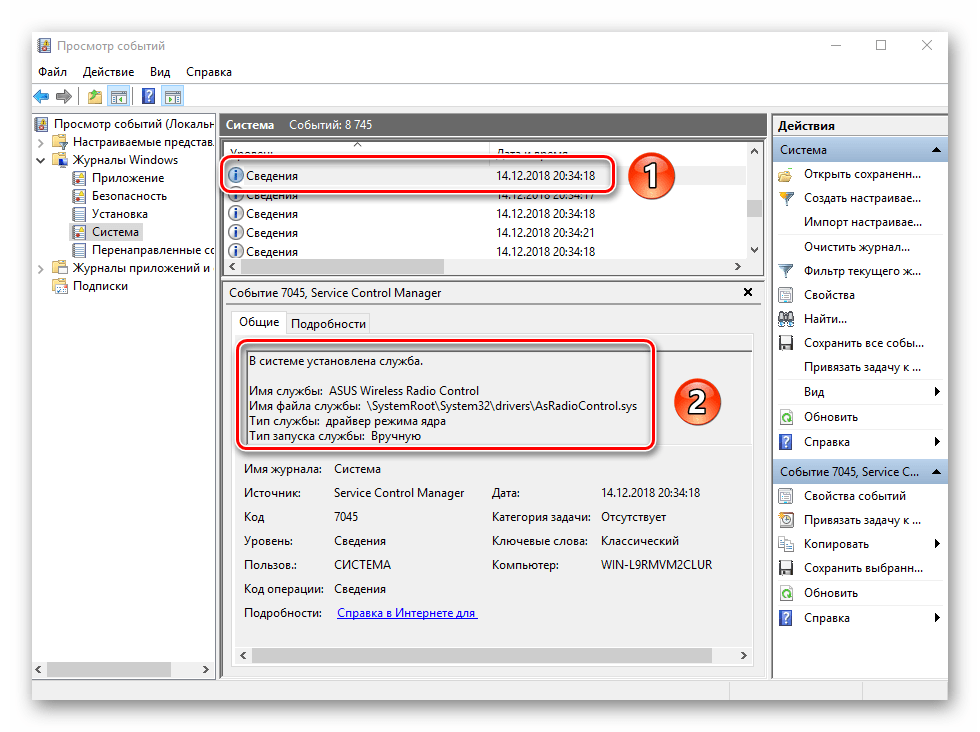
Подобная информация будет очень кстати для тех пользователей, которые не хотят устанавливать сторонний софт для просмотра последних действий Windows 10.
Как видите, процесс активации, запуска и анализа журнала ошибок очень прост и не требует от вас глубоких познаний ПК. Помните, что таким образом можно узнать информацию не только о системе, но и о других ее компонентах. Для этого достаточно в утилите «Просмотр событий» выбрать другой раздел.
Наша группа в TelegramПолезные советы и помощь
Для различных событий и ошибок системы и приложений Windows ведёт журналы событий, которые можно просмотреть и получить дополнительную информацию, которая может быть полезной при решении проблем с компьютером.
В этой инструкции для начинающих — способы открыть просмотр событий Windows 11/10 и дополнительная информация на тему, которая может пригодиться. На близкую тему: Как отключить журнал событий в Windows.
Контекстное меню кнопки Пуск и поиск
Самый быстрый способ перейти к просмотру журналов событий в Windows 11 и 10 — нажать правой кнопкой мыши по кнопке «Пуск» или нажать клавиши Win+X на клавиатуре и выбрать пункт «Просмотр событий» в открывшемся меню.

Ещё один простой и в большинстве случаев работающий способ открыть какой-либо системный инструмент, расположение которого вам неизвестно — использовать поиск в панели задач.
Начните вводить «Просмотр событий» в поиске, после чего запустите найденный результат:
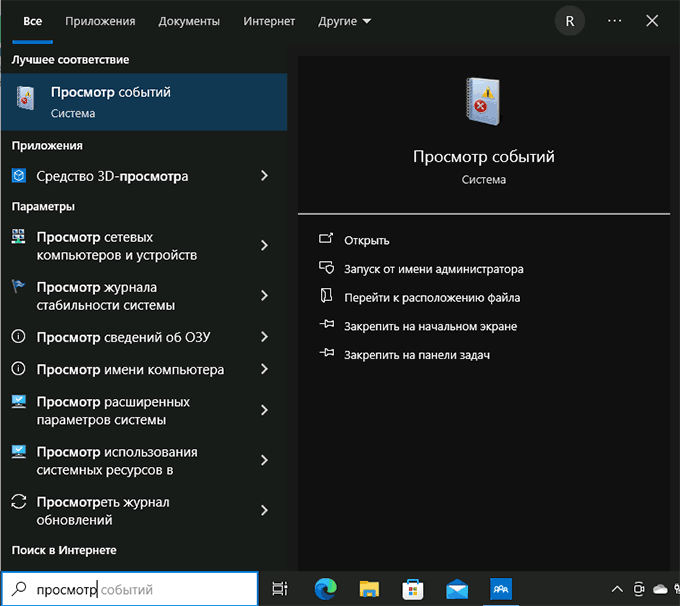
Почему не «Журнал событий» или «Журнал ошибок», которые пользователи обычно ищут? Причина в том, что сами журналы — это файлы на диске в папках
C:\Windows\System32\winevt\Logs C:\Windows\System32\LogFiles
Пользователи, задавая вопрос о том, где журнал событий в Windows, обычно имеют в виду именно системный инструмент «Просмотр событий» для удобного просмотра соответствующих журналов.
Команда «Выполнить»
Самый быстрый и часто используемый метод запуска просмотра журналов событий Windows — использование команды «Выполнить»:
- Нажмите клавиши Win+R на клавиатуре, либо нажмите правой кнопкой мыши по кнопке «Пуск» и выберите пункт «Выполнить».
- Введите eventvwr.msc (или просто eventvwr) и нажмите Enter.
- Откроется «Просмотр событий».
Эту же команду можно использовать для создания ярлыка или для открытия журнала событий в командной строке. Возможно, вам пригодится информация о других полезных командах «Выполнить».
Обычно описанных выше вариантов бывает достаточно для открытия просмотра журналов событий и ошибок в Windows, но есть и другие подходы:
Помимо просмотра журнала событий, в Windows присутствует ещё один полезный инструмент — Монитор стабильности системы, позволяющий наглядно получить информацию о работе вашей системы по дням на основании данных из журнала событий.
If you’re like most Windows 10 users, you might not know that your computer keeps logs of everything that goes in it. Furthermore, you can use these logs to troubleshoot any security issues on your Windows PC.
Simply put, system and security logs are records of events and activities on your PC. These provide valuable insights into what’s happening on your computer, from software errors and bugs all the way to security breaches.
In this beginner’s guide, we will explore what system and security logs are, how to access them, and how to interpret them. Regardless of your experience, you’ll learn how to use system and security logs to improve the performance and security of your computer.
Understanding Windows 10 Logs: Types and Importance
As a Windows 10 user, you might have encountered the term Event Viewer and examples of various logs on your PC. But what exactly do these terms mean, and how do they impact your PC’s operation?
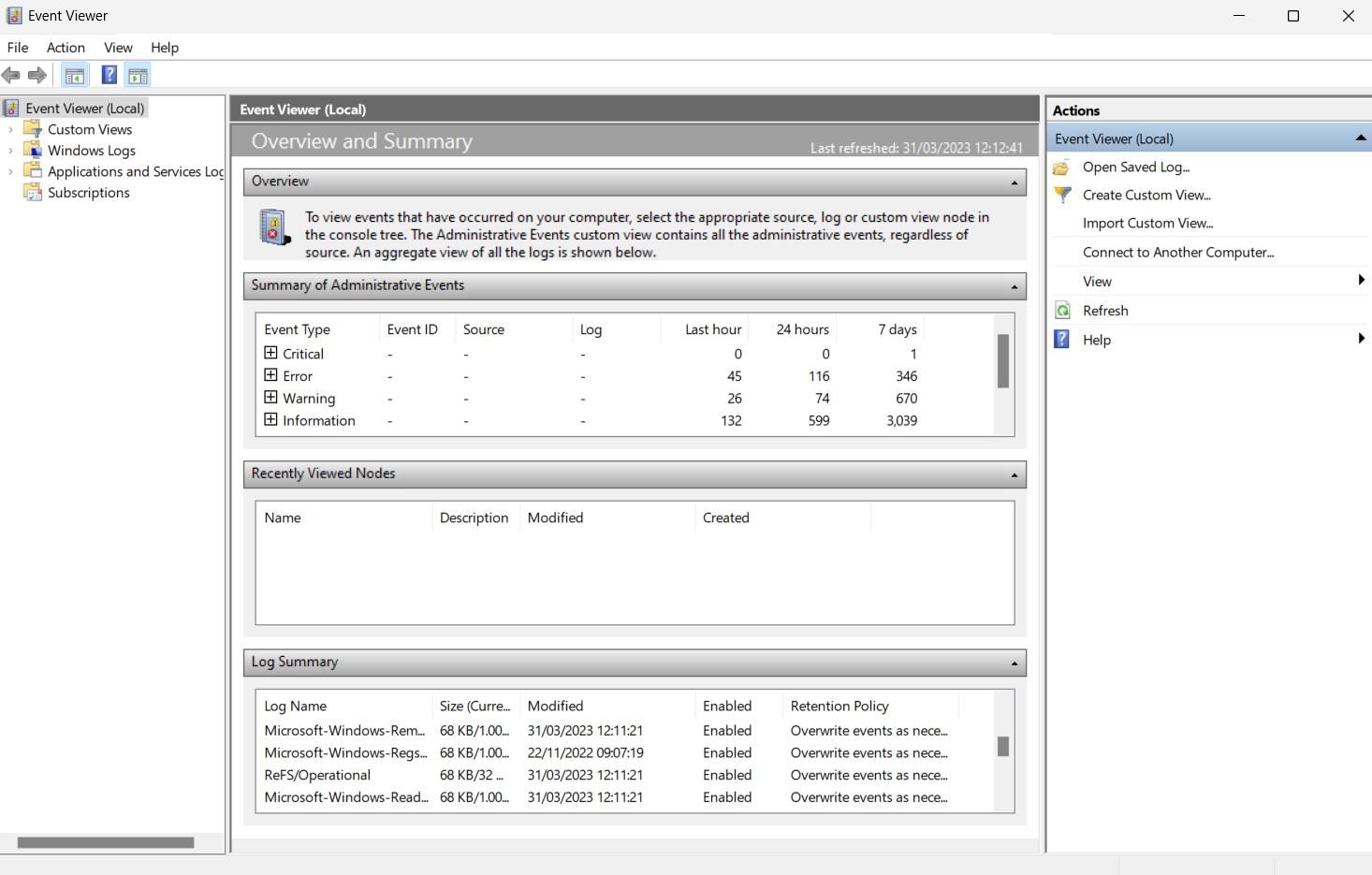
1. System Logs
System logs are files that record events related to the operation of your Windows operating system. Examples include driver installations, system shutdowns, application errors, and hardware failures.
Think of system logs as a diary of your computer’s activities. They track events on your computer and when they happen. You can use these to troubleshoot computer hardware issues.
2. Security Logs
Next, we have Security logs. These logs are files that capture security-related events on your computer. It is worth noting that security logs are crucial in checking if your computer is infected with malware and preventing it in the future.
Examples of security logs include login attempts, changes to security policies, changes to your user accounts, or attempts to access files or programs that require administrative privileges.
3. Application Logs
Application logs record events related to specific applications installed on your PC. Types of application logs include errors and warnings generated by applications, successful and failed login attempts, and program crashes.
4. Setup Logs
Setup logs are generated during the installation of Windows 10 and record every step of the process. They can help diagnose issues related to the installation of the operating system or specific updates.
5. Explorer Logs
These logs record all events related to Internet Explorer on your PC. Examples include browsing history, download history, and website errors. Internet Explorer logs can also help troubleshoot browsing and website compatibility issues.
6. Event Trace Logs
Finally, we have Event Trace Logs which capture detailed information about system events and activities. Developers and IT professionals typically use them for diagnosing complex issues and optimizing your system’s performance.
Why are System and Security Logs Essential?
The answer is simple. When something goes wrong on your computer, system logs help you identify the source of the problem and find a solution. For instance, you can check system logs whenever your PC freezes. That way, you can determine the reasons why your computer keeps on crashing.
Similarly, security logs help you identify and prevent potential security breaches on your computer system. By monitoring security logs, you can detect and prevent unauthorized access to your system and other security threats.
In addition to troubleshooting and security, system and security logs are also crucial for regulatory compliance. After all, many organizations are required to maintain detailed records of their computer systems’ activities to comply with industry-specific regulations.
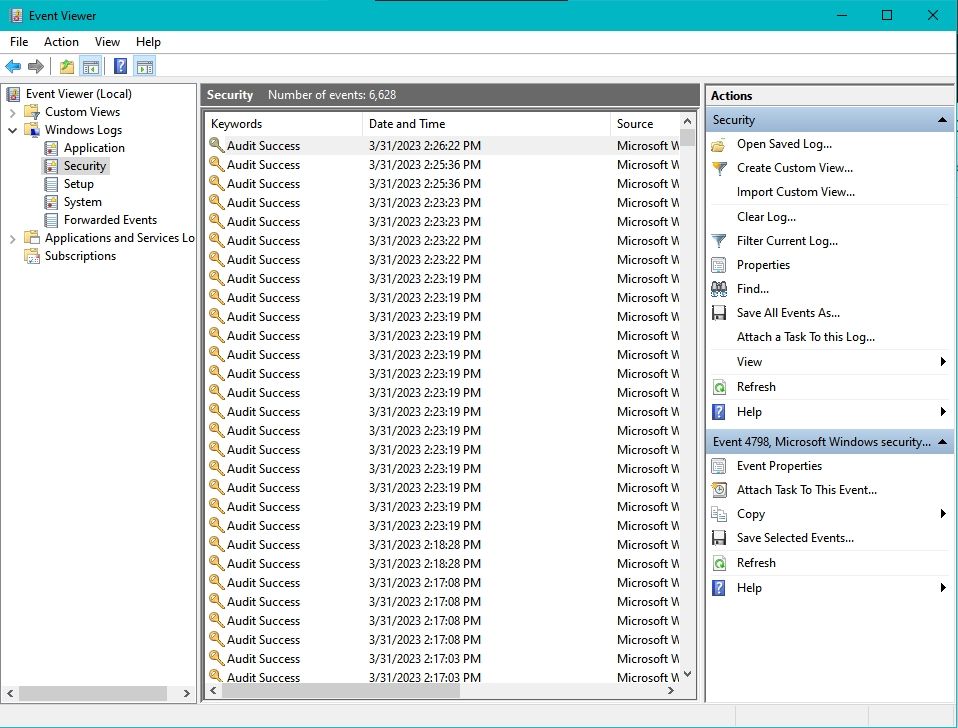
Finally, system and security logs are essential for administrators and IT professionals. They rely on these logs to manage and monitor computer systems to optimize performance. Without access to these logs, system admins would find resolving issues more challenging.
How to Access and Interpret Windows 10 System and Security Logs
Using the Windows 10 system and security logs may seem daunting, but it’s a relatively straightforward process. You can access your system and security logs with the Windows Event Viewer. You can check our primer on the Windows Event Viewer app if you want to know more about it.
To access your Windows 10 system logs, click the Start menu and type Event Viewer in the search bar. Select the Event Viewer app that appears in the search results.
Once you’ve launched the Event Viewer app, find the Windows Logs folder on the left-hand side of the screen and click on System.

You should now see a list of system events logged on your computer.
Accessing the security logs is largely similar. Find the Windows Logs folder on the left-hand side of the Event Viewer window and click on Security.
Interpreting System and Security Logs in Windows 10
Once you’ve accessed the system or security logs, you’ll see a list of events that have been logged. Each event contains detailed information about what happened on your computer system, including the date, time, source of the event, and a description of what occurred.
To effectively interpret the information in an event log, you must understand what each field means.
First, the Event ID field shows a unique identifier for each log, which you can use to search for more detailed information online. By referencing the Event ID, you can better understand the specific type of event that occurred.
Another critical field to understand is Source, which identifies the software or component that generated the event. You can use this information to find the event’s root cause and potentially troubleshoot any related issues.
Date and Time provides a timestamp of when the event occurred. It allows you to track the sequence of events and identify any patterns or trends.
Likewise, Category gives additional context to the event, indicating whether it’s an error, warning, or informational message. This helps you to prioritize events and determine which ones require immediate attention.
Finally, the Description field provides a detailed explanation of what occurred during the event. This information is critical for understanding the event’s impact and identifying any corrective steps.
By thoroughly reviewing each field, you can better understand the information provided in an event log.
Types of Events Recorded in Windows 10 System and Security Logs
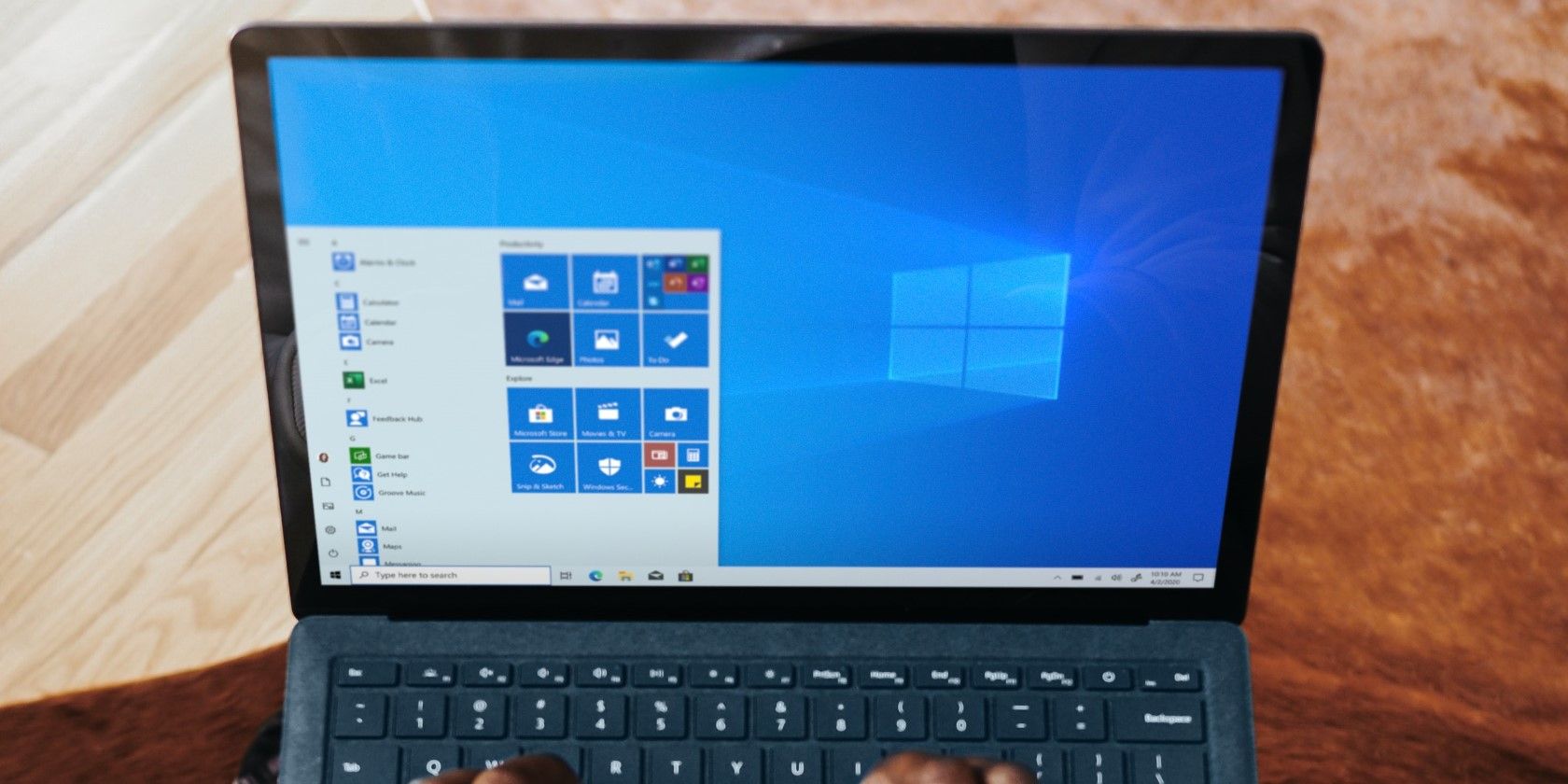
Some of the various events that are recorded in the Windows 10 system and security logs are:
1. System Startup and Shutdown Events
These are some of the most common events recorded in your Windows 10 systems and security logs. They log when your computer is turned on and off and can help diagnose issues related to power management.
For example, if your computer is experiencing issues with starting up or shutting down, you can check the system logs to see if any events were recorded during those times. This information can help you identify the cause of the issue and take appropriate action.
2. Driver Installation and Removal Events
These events detail when a new driver was installed, or an existing driver was removed from your system. Consequently, this information can help identify driver-related issues.
If your computer is experiencing issues with a particular device or peripheral, you can check the system logs to see if any events were recorded during the installation or removal of its drivers. This information can help you troubleshoot the issue.
3. System Errors and Warnings
These events provide details about errors or warnings on your system, such as driver failures or application crashes. For example, if an application crashes frequently or fails to start, you can check the system logs to see if any events were recorded during those times.
This information can help you diagnose and fix the issue by updating the application or troubleshooting the system components that caused the error.
4. Logon and Logoff Events
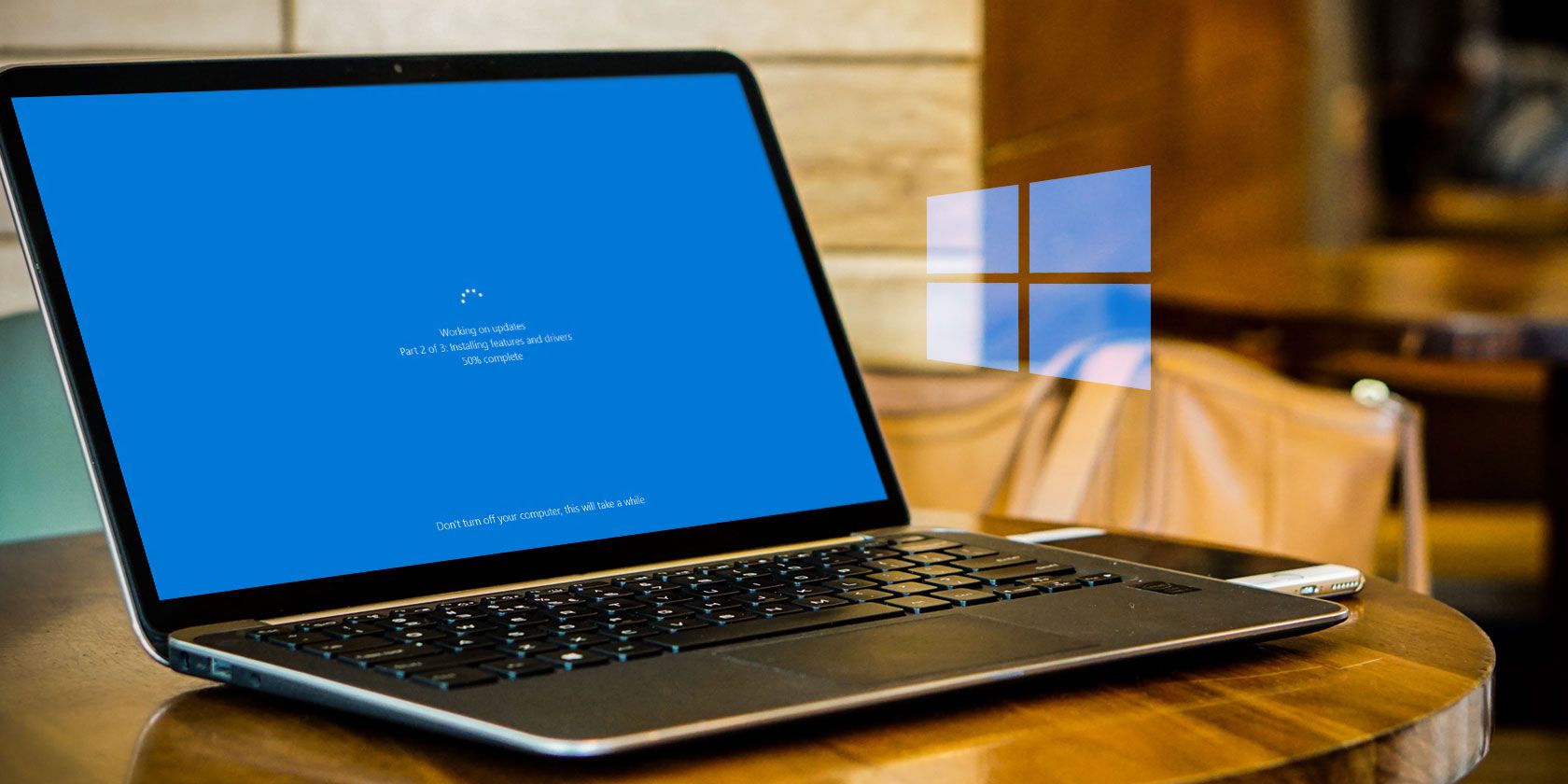
Logon and Logoff events provide details about when a user logs on or off your Windows PC, which can be useful for tracking user activity and detecting potential security threats.
If you suspect someone has unauthorized access to your computer, you can check the security logs to see if any suspicious logon or logoff events were recorded.
Unlocking the Full Potential of Windows 10 System and Security Logs
Learning how to access and interpret Windows 10 system and security logs is crucial in maintaining the health and security of your computer. With this, you can troubleshoot issues, detect potential security threats, and keep your system running smoothly.
Moving forward, you can explore advanced techniques for getting the most out of these tools. Thus, allowing you to improve your computing experience.
Windows 10 comes with a powerful logging system known as the Event Viewer, which records detailed information about system activities, application behavior, and security events. Understanding how to leverage Windows Event Logs is essential for troubleshooting issues, monitoring system performance, and enhancing security.
Windows 10 primarily maintains three main types of event logs:
- Application Logs – Capture events related to installed applications.
- System Logs – Record system-level events, such as hardware failures or driver issues.
- Security Logs – Track security-related events, including logins, policy changes, and access attempts.
This guide covers how to access, configure, and analyze Windows 10 event logs for better system management and troubleshooting.
Log & Configuration File Locations
Before exploring the details, it’s essential to understand where Windows 10 stores its logs:
| Log Type | Location |
|---|---|
| Application Logs | Windows Event Viewer > Windows Logs > Application |
| System Logs | Windows Event Viewer > Windows Logs > System |
| Security Logs | Windows Event Viewer > Windows Logs > Security |
| Setup Logs | Windows Event Viewer > Windows Logs > Setup |
| Custom Logs | Windows Event Viewer > Applications and Services Logs |
All logs are stored in binary format files in the directory:
C:\Windows\System32\winevt\Logs\
Understanding Windows 10 Application Logs
What Are Application Logs?
Application logs capture events logged by installed software. These logs are useful for:
- Troubleshooting software issues
- Monitoring application behavior
- Identifying application crashes or misconfigurations
Accessing Application Logs
To access application logs:
- Open Event Viewer:
- Press
Win + R, typeeventvwr, and press Enter.
- Press
- Expand Windows Logs.
- Click on Application to view a list of events.
Sample Application Log Entry
Level: Error
Source: Application Error
Event ID: 1000
Task Category: (100)
Message: Faulting application name: chrome.exe, version: 114.0.5735.198, faulting module name: ntdll.dll, exception code: 0xc0000374.
| Field | Description |
|---|---|
| Level | Severity of the event (Information, Warning, Error) |
| Source | The application or service that generated the event |
| Event ID | Numeric code that identifies the event |
| Message | Description of the event |
Understanding Windows 10 System Logs
What Are System Logs?
System logs capture system-related events, such as hardware changes, driver updates, and operating system errors. These logs are critical for:
- Diagnosing system failures
- Troubleshooting hardware and driver issues
- Monitoring system performance
Accessing System Logs
To access system logs:
- Open Event Viewer.
- Expand Windows Logs.
- Click on System to view system events.
Sample System Log Entry
Level: Warning
Source: Microsoft-Windows-Kernel-Power
Event ID: 41
Message: The system has rebooted without cleanly shutting down first. This error could be caused if the system stopped responding, crashed, or lost power unexpectedly.
Explanation: This log entry indicates that the system was shut down improperly, which could point to a power failure or crash.
Understanding Windows 10 Security Logs
What Are Security Logs?
Security logs track security-related events, such as user logins, failed access attempts, and changes to system permissions. These logs are essential for:
- Monitoring unauthorized access
- Auditing user activity
- Detecting security breaches
Accessing Security Logs
To access security logs:
- Open Event Viewer.
- Expand Windows Logs.
- Click on Security to view security events.
Sample Security Log Entry
Level: Information
Source: Microsoft-Windows-Security-Auditing
Event ID: 4624
Task Category: Logon
Message: An account was successfully logged on. Subject: Security ID: S-1-5-18 Account Name: DESKTOP-12345$ Account Domain: WORKGROUP
| Field | Description |
|---|---|
| Level | Severity (Information, Success, Failure) |
| Source | Service or application that generated the event |
| Event ID | Unique identifier for the event |
| Task Category | Context of the event (e.g., Logon) |
| Message | Detailed information about the event |
Common Security Event IDs
| Event ID | Description |
|---|---|
| 4624 | Successful logon |
| 4625 | Failed logon attempt |
| 4672 | Special privileges assigned to a new logon |
| 4688 | A new process has been created |
| 4719 | System audit policy was changed |
Creating Custom Logs
Windows 10 allows you to create custom event logs to monitor specific applications or system behaviors:
- Open Event Viewer and navigate to Applications and Services Logs.
- Right-click and select Create Custom View.
- Define the event sources, levels, and IDs you want to track.
- Save the custom view with a meaningful name.
Configuring Event Log Size and Retention
To prevent event logs from consuming too much disk space, you can adjust their size and retention policies:
- Open Event Viewer.
- Right-click on a log (e.g., Application) and select Properties.
- Adjust the Maximum log size and Overwrite events options.
Best Practice: Set logs to “Overwrite as needed” to avoid filling up disk space.
Using PowerShell to Access Event Logs
PowerShell provides a powerful way to query and filter event logs:
Get a list of available logs:
Get-EventLog -ListView the most recent entries in the System log:
Get-EventLog -LogName System -Newest 10Filter logs by Event ID:
Get-EventLog -LogName Security -InstanceId 4624Mastering Windows 10 Event Logs is essential for effective system administration, troubleshooting, and security monitoring. By leveraging the Event Viewer and PowerShell, you can gain deep insights into your system’s operations, quickly identify issues, and enhance overall security.
Use this guide to optimize your event log management and improve your Windows 10 troubleshooting skills.
Has your computer with Windows 10 operating system just crashed suddenly and you are right now searching for a way to view crash logs in Windows 10 then you have come to the right place. This is where we can guide you on how you can check crash logs in Windows 10.

Table of Contents
Windows crash may be because of a lot of reasons like overheating of the system or some fault in the driver installed. This is where the crash logs option comes in use for you can see what has caused the crash and other info like the name of the log and the EventID.
What Causes Windows 10 to Crash?
The users that face this kind of crash the first time may think that the reason behind this might be confusing and it will not be worth it to know. But the point to focus on here is the fault might not be with the components of Windows 10 and there must be an external reason that you can check in Windows crash report.
- Issue in RAM: There is a high possibility that your computer RAM is not working at the optimum level and that is what causes your PC trouble in retrieving data from memory whensoever you are trying to do so.
- Overheated System: With low RAM size or any other compatibility issue in the motherboard you may face an overheating of the system that is causing your PC to crash or freeze.
- Incompatible Driver: It is a common habit to install new drivers for our system when our pre-installed drivers get outdated and start to make any function of the PC lag. But these drivers may in all possibility contain some viruses or bugs that can potentially harm and cause our system to crash.
- Issue with Hard Drive: Hard drives contain most of the data in your PC and any fault can create a situation that most probably will lead to a crash where a Windows 10 blue screen log is.
Microsoft’s investigation identifies the following as the primary reasons why Windows crashes:
- 70% of accidents are the result of rogue driver code.
- 10% of the total is accounted for by hardware issues.
- 15% of the cases include unknown causes.
- 5% of the issues are the result of Microsoft code.
You can check our guide to Fix Windows 10 Crashing Randomly.
Here, we have listed the ways to check crash logs in Windows 10.
Method 1: Through Event Viewer
Event viewer is an inbuilt app to view crash logs in Windows 10. You may view the event logs on your computer using the Event Viewer component of the Windows operating system. Application and system messages, such as informative messages, errors, warnings, etc., are logged by Event Viewer. You may identify the specific reasons why your computer crashes using Event Viewer and it is one of the easiest ways to get Windows crash reports.
1. Go to the Windows Cortana Search box and type Event Viewer. Click on Open.

2. Click on Windows log. This is where you will get all logs including Windows 10 blue screen log.

3. Then, choose System from the drop-down menu.

4. On the event list, click Error. Then you can view all the information about Windows crash reports.

Also Read: How to Clear All Event Logs in Event Viewer in Windows 10
Method 2: Through Reliability Monitor
There is another tool to get reliable information and view crash logs in Windows 10. It is called a Reliability Monitor and as the name suggests, it is a great choice to depend on in case your Windows 10 PC crashes. Below are the steps that will help you guide on how to use this to check crash logs in Windows 10.
1. Again, go to Windows 10 Cortana search box and type Reliability Monitor, and click on Open.

2. You will see on the interface Reliability Monitor is generating the report Please wait.

3. You will see Stability Index.

It assesses your overall system stability on a scale from 1 to 10. You can select any week or any day to review specific hardware or software problems that troubled your system. The horizontal line in blue will show you the score.
Note: stability index does not take into account warning and informational events when it calculates the stability score from 1 to 10.
The report records 3 failures which are application failure, Windows failure, and miscellaneous failure. Moreover, it records informational events and warnings. The table below shows how these failures, informational events, and warnings.
| Icon | Information it shows |
| Blue info icon | Informational events |
| Red cross icon | 3 failures |
| Yellow exclamation icon | Warning |
4. Then out of all these crash dates if you want any information about a particular date what you got to do is just, click on that date’s column. This will open a new window displaying all the information.

5. Click on View all problem reports.

Now, you will see all crash log details.

Also Read: Fix The Procedure Entry Point Error on Windows
Method 3: Through Windows PowerShell
Third and the final method to check cash logs in Windows 10 is using the Power Shell tool. Power Shell is a great application that is used in automating the management system with the use of a scripting language. Read below to understand how you can use this application to view crash logs in Windows 10.
1. Go to the Windows 10 Cortana search box and type PowerShell. Click on Open after finding the top search result.

2. Type the following command into the command box. The crash logs will be retrieved together with their Index, Time, EntryType, Source, InstanceID, and Description using this command.
Get-EventLog -Log system | where {$_.entryType -match "Error"}

3. Get the most recent crash logs up to the specified number by using the Newest argument. Run the following command to collect the 20 most recent crash logs:
Get-EventLog -LogName System -Newest 20 -EntryType Error

Frequently Asked Questions (FAQs)
Q1. Where do I find information about my computer crashing?
Ans. You can use Event viewer which is an in-built app in Windows 10, you can also use reliability monitor which is a user-friendly application and you can also use PowerShell application which is an open-source CLI tool.
Q2. What are the most frequent crashes in Windows 10?
Ans. The three most frequent crashes in Windows OS are fault at the application level, the software hangs unexpected restart and shutdown. There are other reasons also but these are common reasons as per Microsoft investigation.
Q3. Where can I find crash log in Windows 11?
Ans. You can use Event Viewer to see the crash logs in Windows 11. In the event viewer app, move to the Windows log. Then search error and tap on the error. Detailed information will be shown for the error.
Q4. Why does my PC keep crashing and freezing?
Ans. There are a number of reasons for crashes and freezing. Some common reasons are overheating, issues with memory, faulty hardware and software, malicious files, corrupted system registry files, and too little available memory.
Recommended:
- Fix Windows Does Not Have Enough Information to Verify This Certificate Solutions
- Why is my Computer Making Funny Noises?
- Fix Hard Disk Problems in Windows 10
- Fix Event 1000 Application Error in Windows 10
The Windows PCs are designed in a way that they can store all the crash log information in your crash log so you can at any time view crash log information in Windows 10. We hope that these methods might have helped you to view crash logs in Windows 10.

